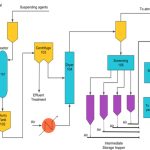Flow meter is the quantification of bulk and fluid movements . Flow are generally measured in many different ways. Positive-displacement flow meters accumulate a set volume of fluid and then count the number of times the volume is filled to measure flow. Other flow measurement methods depend on forces produced by the flowing stream as it overcomes a known constriction, to indirectly calculate flow. Flow may be measured by measuring the velocity of fluid over a known area.
When we’re talking about flow meter, there are several type flow meter already know. The most common principals for fluid flow metering are:
Differential Pressure Flowmeters
● In a differential pressure drop flowmeter devices, the flow is calculated by measuring the pressure drop over an obstructions inserted in the flow. As we know also, the differential pressure flowmeter is based on the Bernoullis Equation, where the pressure drop and the further measured signal is a function of the square flow speed. In variable-area meters, fluid flowing through a slightly tapered tube causes a float, piston, or vane to change position inside the tube, adjusting the area available for fluid to pass through. The fluid velocity determines the final float position.

Velocity Flowmeter
● In a velocity flowmeter the flow is calculated by measuring the speed in one or more points in the flow, and integrating the flow speed over the flow area.Since velocity flowmeters operate under the assumption of a constant velocity profile, they are inaccurate for flows in the laminar regime. This inaccuracy occurs because there is a large difference between the fluid velocity at the wall and at the center of the pipe. This property makes velocity flowmeters especially sensitive to piping geometry and Reynolds number.

Positive Displacement Flowmeters
● Positive displacement flowmeters are some of the most accurate flowmeters available today. They can easily obtain flow measurements within 0.1% of the true value. They are unique because they are the only type of flowmeter that directly measures the volumetric flowrate. The positive displacement flowmeter measures process fluid flow by precision-fitted rotors as flow measuring elements. Known and fixed volumes are displaced between the rotors. The rotation of the rotors are proportional to the volume of the fluid being displaced.Positive displacement flowmeters measure flowrate through the continuous filling and emptying of a chamber of known volume. Positive displacement flowmeters differ from positive displacement pumps only in that, rather than being driven by motors, they are driven by the fluid flowing through them.

Mass Flowmeter
● Mass flowmeters measure flow in one of two ways: inferentially or directly. Imagine a ball traveling horizontally through a pipe. Now suppose the pipe rotates around a horizontal axis. The pipe would inflict a force on the ball, which the ball would counter. There are several types of mass flowmeter known with their type or function. Its Coriolis Flow Meter and thermal meter.
● Coriolis mass flowmeters are true mass meters in that they directly measure mass flowrates, as opposed to volumetric flowrates. These flowmeters operate based on the Coriolis principle. In coriolis meters liquid travels through a vibrating U-shaped or straight tube. Coriolis meters typically consist of a U-shaped flow tube outfitted with a magnetic driver and two electromagnetic sensors. The driver, located at the bend of the tube, causes the tube to vibrate slightly up and down, much like a tuning fork.

Open Channel Flowmeters
In open channels, liquid flows with a free surface. Common examples of open channels are tunnels, non pressurized sewers, partially filled pipes, canals, streams, and rivers. Flow measurement through open channels is based upon the head, or depth, of the fluid. As liquid flows across weirs or flumes (the two main types of open channel measurement devices) the head changes. The difference in head across the device indicates the flow rate.


